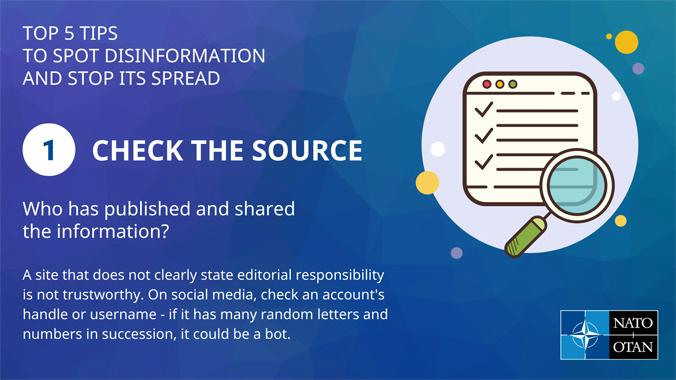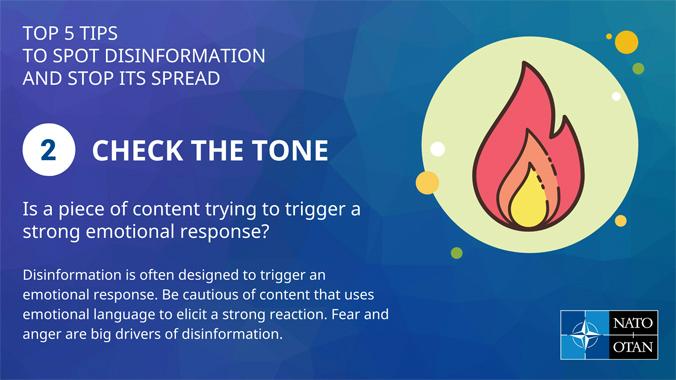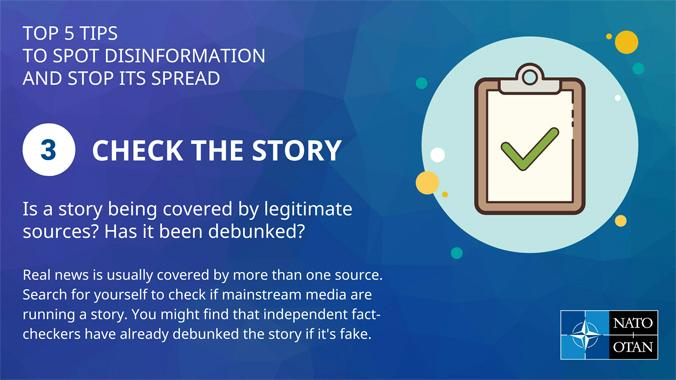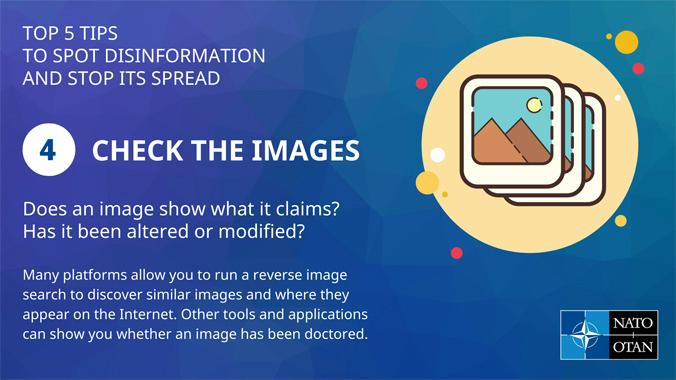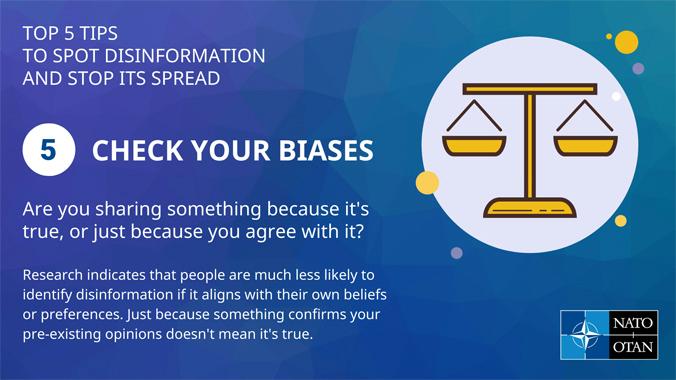NATO’s approach to counter information threats
Malign actors routinely conduct hostile information operations against NATO, its member countries and its partners. Information threats are intentional, harmful, manipulative and coordinated activities – including information manipulation and interference by foreign actors and disinformation spread through traditional and social media – designed to create confusion, deepen divisions, destabilise societies and ultimately weaken the Alliance. NATO works closely with Allies and partners to understand, counter and build resilience against these information threats.

Photo credit: Filippo Bacci via Getty Images
- NATO has been dealing with information threats since its creation in 1949 and has been actively countering a significant increase in hostile information activities since Russia’s illegal annexation of Crimea from Ukraine in 2014.
- Disinformation in its original sense described the intentional spread of false and/or misleading content. Today, however, this word has become an umbrella term for different kinds of phenomena in the information space, including as a label for opinions and narratives that contradict an actor’s own opinion. It is therefore no longer adequate to describe the real threat to democracies – the intentional manipulation of the information environment by foreign state and non-state actors through manipulative tactics, techniques and procedures (TTPs).
- NATO’s approach focuses on “information threats”, a more precise description of the broad range of hostile information activities conducted by state and non-state actors, including hostile information operations, information manipulation and interference by foreign actors, and disinformation. NATO’s approach does not prescribe what people can or cannot say and protects freedom of expression.
- NATO’s responses to information threats include short, medium and long-term response options, including proactive measures. Responses are based on four key functions: (1) understanding the information environment, (2) preventing the effectiveness of information threats, (3) containing and mitigating specific information incidents, and (4) recovering stronger by learning lessons from information threats.
- Proactive communication is one of the key tools to counter information threats. The Alliance communicates with audiences through various channels, providing accurate information that helps people recognise and resist information threats.
What are information threats?
Why are information threats so dangerous?
Why does NATO care about information threats?
How does NATO counter information threats?
Information threats in focus: How can you stop the spread of disinformation?
What are information threats?
Information threats are intentional, harmful, manipulative and coordinated activities, conducted by state and non-state actors to weaken and divide NATO, its members and its partners. These hostile information activities can include many different TTPs designed to manipulate public opinion.
Misinformation is therefore excluded from the definition of information threats. This phenomenon describes false or inaccurate information spread without malicious intent. However, the effects of misinformation can still be harmful, making proactive communications and easy access to facts even more important.
Key terms:
- Disinformation – false or inaccurate information spread deliberately to manipulate the opinions and actions of others
- Propaganda – information designed to manipulate a specific target audience toward a particular behaviour or belief, often as part of a prolonged campaign by a state actor with a political agenda
- Information Manipulation and Interference by Foreign Actors (IMIF) – a pattern of behaviour that threatens or has the potential to negatively impact values, procedures and political processes in a target country. Such activity is mostly non-illegal, but is manipulative in character, conducted in an intentional and coordinated manner, by state or non-state actors, including their proxies inside and outside of their own territory
- Hybrid warfare – use of military and non-military as well as covert and overt means (including disinformation, cyber attacks, economic pressure, deployment of irregular armed groups and use of regular forces) to blur the lines between war and peace, sow doubt in the minds of target populations, and destabilise and undermine societies.
Why are information threats so dangerous?
Information threats may constitute a national security threat. Strategic competitors are constantly seeking to exploit the openness, interconnectedness and digitalisation of our countries. They interfere in our democratic processes and institutions, challenge our values and target the security of our citizens through hybrid tactics, both directly and through proxies. They also exploit gender narratives and promote gendered-themed information threats to sow division and destabilise societies. This challenges the Alliance’s security, resilience, interests, values and democratic way of life, including fundamental rights like freedom of expression.
Information threats, such as disinformation, tear at the fabric that holds societies together. They undermine people’s trust in governments and other public institutions. They are usually designed to appeal to people’s worst impulses, fears and prejudices – pitting neighbour against neighbour, poisoning social groups against each other, validating and inflaming extremism, degrading people’s feelings of belonging to a community or a country – all in an attempt to divide and conquer a society on the information battlefield.
Rapid technological developments, particularly in the field of artificial intelligence and deepfakes, have the potential to further undermine public trust in communications by amplifying hostile information operations, creating confusion in the information environment and altering perceptions in subtle but significant ways.
Information threats are not always designed to persuade people to believe a hostile narrative or a specific lie. Sometimes they are designed to confuse and to muddy the waters with contradictory information in order to prevent people from differentiating between fact and fiction. Some people will be swayed by malign information and help it spread. Others will be frustrated by the flood of lies and completely disengage. Both of these outcomes can be useful to hostile actors seeking to degrade the resilience of a society.
Ultimately, information threats are able to provoke real-world harm. Protecting 1 billion citizens from these threats is therefore a national security priority. NATO, Allies and NATO partners have an essential role to play to counter information threats through a whole-of-society approach.
Why does NATO care about information threats?
NATO’s success as a collective defence alliance depends on the strength and resolve of its member countries. Any information manipulation and interference by foreign actors that attempts to weaken Allied societies – and thereby degrade NATO’s ability to protect its members – is therefore of interest to NATO.
Furthermore, as an alliance of democratic countries, NATO derives its legitimacy from the ongoing trust and support of Allied citizens. This is why NATO itself faces information threats from malign actors –– they seek to diminish public trust and undermine the Organization’s solidarity. These actors deploy a wide range of hostile narratives against NATO (see Setting the record straight for some specific examples).
How does NATO counter information threats?
Coordinating with Allies and partners
NATO’s approach to counter information threats relies on close cooperation with Allies and partners. First and foremost, NATO works with Allied national governments to counter information threats. The Alliance also cooperates with the governments of its partner countries and other international organisations, like the European Union, the G7 Rapid Response Mechanism, the United Nations and the Organisation for Economic Co-operation and Development (OECD). NATO also connects with private companies, media organisations, social media platforms, civil society organisations and academic institutions to learn more about information threats and to develop strategies to mitigate its effects.
Cooperating with all relevant stakeholders helps all parties develop a comprehensive picture of current information threats. Each stakeholder can build off the insights of others, identifying malign actors and hostile narratives more rapidly, and responding to information threats in a more agile and coordinated way. All actors in the information environment – from large organisations like NATO to individual people in member and partner countries – have a part to play in countering information threats.
NATO’s response options
Building off this cooperative approach, the responses to information threats include short, medium and long-term response options, including proactive measures. These options ensure flexibility and the ability to scale up or down depending on the threat, and support NATO’s strategic communications objectives and priorities. The responses are based on four key functions: Understand, Prevent, Contain and Mitigate, and Recover.
Understanding the information environment
NATO must understand the information environment in order to respond effectively to information threats. To that end, NATO continually tracks and analyses information relevant to the Alliance, including by monitoring and identifying sources of the threat as they emerge and propagate. NATO’s Information Environment Assessment (IEA) capability is a combination of skilled people, repeatable processes and technology that uses internal, Allied and external sources to guide communications planning and execution, and shape the Alliance's response to information threats. Information is analysed using an ABCDE model, seeking to understand the actor, behaviour, content, degree and effect of any potential information threat. In addition to analysing information threats, the IEA capability also enables NATO to evaluate the effectiveness of its own public communications. NATO also enhances its understanding of the information environment through regular media monitoring and analysis.
Preventing the effectiveness of information threats
An important element in countering information threats is proactively sharing accurate information. Through open, transparent and clear public communications, NATO is able to “pre-bunk” potential information threats, anticipating hostile narratives and getting out ahead of their spread. These activities help build societal resilience against information threats, diminishing their effectiveness.
The Alliance engages with the public through a wide variety of channels, including social media, media relations with journalists and the NATO website. NATO is fully committed to transparency and regularly publishes information about its activities and plans, for example by sharing a schedule of NATO and Allied military exercises well in advance. All of NATO’s communications activities are in line with the Alliance’s core democratic values, including freedom of speech and freedom of the press.
In addition to its digital and media communications, NATO also engages directly with people from NATO members (Allies) and non-member countries (partners) to promote a better public understanding of the Alliance’s purpose, values, policies and activities. Through these engagements, NATO builds relationships and helps strengthen resilience against information threats among audiences who may be targeted by malign actors. These stakeholders can then share the knowledge they acquire through these interactions, expanding resilience to information threats through their own networks. NATO provides grants to non-governmental organisations, universities and think-tanks to fund projects that contribute to better understanding of the Alliance in their home countries as well as projects specifically designed to counter information threats.
In order to reach audiences that are less likely to follow the Alliance’s activities, NATO also runs specific communications campaigns. For example, under the Protect the Future campaign, NATO has been working with young content creators from across the Alliance, helping them go behind the scenes at NATO Headquarters, meet the experts and discover what NATO does – and giving young people a voice in telling NATO's story in their own way.
Beyond these public communications activities, NATO also works to prevent the effectiveness of information threats by building and maintaining expert networks with relevant stakeholders through the NATO Rapid Response Group (NRRG). This group provides early warning of emerging information threats, giving NATO and Allies greater situational awareness and rapid response capability. It also enables all stakeholders to share best practices for increasing information integrity. The NRRG compliments other collective response mechanisms, such as the EU Rapid Alert System (RAS) and the G7 Rapid Response Mechanism (G7 RRM), where NATO is an observer.
Containing and mitigating information threats
Information threats often use narratives that are deliberately sensational and provocative; at the same time, manipulative tactics like fake accounts or coordinated inauthentic behaviour help amplify content beyond what it could have achieved through organic amplification. As such, in many cases, the best way to deal with information threats is to recognise them as such and refuse to engage. But in some cases, especially when an incident has already spread far and wide, it’s worth directly addressing it for example through debunking or exposure of a campaign or activity. In those cases, NATO can set the record straight with its public communications on the NATO website, social media and through coordinated statements to media and the public. NATO has directly and repeatedly called out the Kremlin’s litany of lies in regard to its war of aggression against Ukraine, and continues to debunk Russian myths directed against NATO.
Recovering quickly by learning lessons from information threats
An assessment of the TTPs used and the vulnerabilities exploited by malign actors enables NATO and Allies to develop more effective responses to prevent, contain or mitigate future information incidents. This assessment contributes to the key objective of the Alliance: to strengthen the resilience of NATO and its societies. Insights into malign actors’ patterns of behaviour further strengthens NATO’s and Allies’ situational awareness. Furthermore, the assessment of incidents and campaigns supports long-term investment in instruments like awareness raising and strategic communications, as well as fine-tuning the response options available to prevent, contain and mitigate.
Information threats in focus: How can you stop the spread of disinformation?
Information threats can feel overwhelming – as if everything we see online is fake and everyone is complicit in spreading lies. But there are simple things we can all do to make sure that we’re not contributing to the problem. Click through the gallery below to see the top five tips to spot disinformation and stop its spread.

